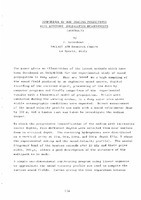| dc.contributor.author | Gerrebout, Jacques | |
| dc.date.accessioned | 2018-10-11T14:05:07Z | |
| dc.date.available | 2018-10-11T14:05:07Z | |
| dc.date.issued | 1971/12 | |
| dc.identifier | 70 | |
| dc.identifier.govdoc | CP-5/1 | |
| dc.identifier.uri | http://hdl.handle.net/20.500.12489/60 | |
| dc.description.abstract | The paper gives an illustration of the latest methods which have been developed at SACLANTCEN for the experimental study of sound propagation in deep water. They are based on a high sampling of the sound field produced by an explosive sound source, digital recording of the received signal, processing of the data by computer programs and finally comparison of the experimental results with a theoretical model of propagation . Trials were conducted during the warming season, in a deep water area where stable oceanographic conditions were expected . Direct measurement of the sound velocity profile was made with a sound velocimeter down to 500 m, and a Nansen cast was taken to investigate the medium deeper. | |
| dc.format | 7 p. : ill. ; digital, PDF file | |
| dc.language | English | |
| dc.publisher | NATO. SACLANTCEN | |
| dc.source | In: SACLANTCEN Conference Proceedings No. 5 part 1, pp. 154-160 | |
| dc.subject | Ray tracing | |
| dc.subject | Acoustic propagation | |
| dc.subject | Acoustic models | |
| dc.title | Comparison of ray tracing predictions with wideband propagation measurements | |
| dc.type | Papers and Articles | |
| dc.type | Conference Proceedings (CP) | |
